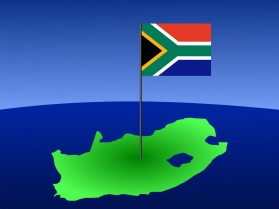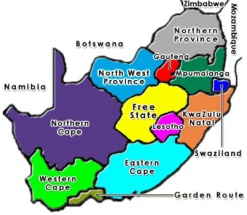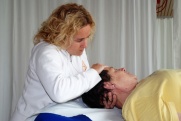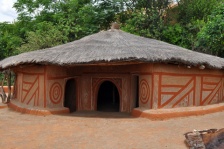South Africa
Original Editor - Mayra Escbach
Top Contributors - Mayra Eschbach, Didzis Rozenbergs, Tarina van der Stockt, Admin, Rosie Swift, 127.0.0.1, Elaine Lonnemann, Fasuba Ayobami, Evan Thomas and WikiSysop
Cape of Good Hope, Capetown , South Africa (Source: Piccaya l Dreamstime.com)
Patient Access to Physiotherapy or Physical Therapy Services / Entry Point[edit | edit source]
Physiotherapists in South Africa have first line practitioner status. By definition, a first line practitioner is a practitioner capable of making a diagnosis and being able to treat. The practitioner must refer if the problem is outside of his/her scope of practice.[1]
Physiotherapists were first recognized as first line practitioners in the 1985 Scope of Practice Document and were acknowledged as such by both the earlier regulating body, the SAMDC (South African Medical and Dental Council) and the current regulating body of physiotherapists, the Health Professions Council of South Africa (HPCSA) who further verified the first line practitioner status of physiotherapists in 1997.[1]
According to HPCSA the Physiotherapist assesses, treats and manages a wide variety of injuries including ailments from the fields of orthopedics, neurology, respiratory, cardio-vascular, obstetrics, sports medicine, pediatrics, geriatrics, intensive care units and general rehabilitation. Other medical fields and community care also falls within the scope of physiotherapy.[2]
As first line practitioners, physiotherapists also practice and work in association with the patients’ medical team and may refer patients for X-rays, refer to a specialist, write and issue sick notes and administer prescribed medicine.[1]
Source: Viasta Sainikova l Dreamstime.com
Therapist Preparation[edit | edit source]
In South Africa the degree (B.PhysT, B.Sc Physio or B.Physio) consists of four years of general practice training, involving all aspects of Physiotherapy. Typically, the first year is made up of theoretical introduction. Gradually, time spent in supervised practice increases until the fourth year, in which the student generally spends about 80% in practice.[3]
In the fourth year, students are also expected to complete Physiotherapy research projects, which fulfills the requirements of an Honours degree.[3]
A compulsory year of community service is completed by the student after graduation. Community service can only be done in the public sector and placement is done by the National Department of Health Community service.[4] There are several institutions around the country that offer recognized courses in Physiotherapy. Each institution has its own criteria for acceptance.[5] Below is the list;
- University of Kwazulu-Natal
- University of Cape Town
- University of the Free State
- University of Pretoria
- University of the Western Cape
- University of Stellenbosch
- University of the Witwatersrand
- Sefako Makgatho Health Science University (SMU)
Degree/Credentialing[edit | edit source]
Regulating body: The Health Professions Council of South Africa (HPCSA or the Council) is the statutory body regulating Physiotherapists, established in terms of the Health Professions Act No. 56. The HPCSA serves to protect the public and provide guidance to registered healthcare practitioners. They regulate the health professions in the Republic of South Africa in registration, education, and training, professional conduct and ethical behavior. They ensure continuing professional development, and compliance with healthcare standards.
There are several Professional Boards that are coordinating bodies for all the healthcare practitioners registered with HPCSA. The respective boards that are established for a specific profession, deal with any matters relating to a specific profession. These boards consist of members appointed by the Minister of Health, educational institutions, and nominated members. The board governing Physiotherapy practice is the Professional Board for Physiotherapy, Podiatry, and Biokinetics.
Registration: Registration with the Health Professions Council of South Africa (HPCSA) is a pre-requisite for professional practice. Registration categories and criteria include the following:
- Physiotherapy Registration of Student–Physiotherapists (PT-S)
- First registration as a Student:, Form 53,Certified copy of ID document or passport with a clear photograph, and Registration fee
- Re-registration after interruption of studies for one year or more: Original certificate of registration as student, Certificate of resumption of study issued by University, and Registration fee
- Re-registration after interruption of studies for less than one year: Form 41, and Certificate of resumption of study issued by University.
Registration of Physiotherapists (PT)- SA Qualifications (Community Service): Form 23 (Community Service), Certified copy of ID document or passport with a clear photograph, Registration fee, A copy of registration certificate with the Health Professions Council of South Africa, and Registration in the category: Public Service : Community Service.
- Independent Practice: Form 23, and Copy of letter from institution confirming completion of 12 months Community Service
- Foreign Qualifications: All foreign qualified Physiotherapists are required to sit for an examination concluded by the Board, twice per year, Form 49 PT, Form 146; Form 176 DOH, Certificate of Status, issued by foreign registration authority, Original certificate of Qualifications or copy thereof certified by Notary Public, and Certified copy of ID document or passport with a clear photograph.
2. Required Continuing Education: every health care professional registered with the HPCSA is required to accumulate 30 Continuing Education Units ("CEUs") per twelve-month period of which at least five CEU's should have been on human rights, ethics and medical law, within every year. Each CEU is valid for 24 months from the date that the activity took place (or ended, in the event of post-graduate studies) after which it would lapse. This means that practitioners should aim to accumulate a balance of 60 CEUs by the end of their second year of practice, and thereafter top-up the balance through additional CPD as each 24 - month validity period expires.[6]
Special Interest Groups[edit | edit source]
Special Interest Groups under South African Society of Physiotherapy (SASP):[7]
- Acupuncture In Physiotherapy Group
- Animal Physiotherapy Group of South Africa
- Aquatic Physiotherapy Group
- Cardio-Pulmonary Rehabilitation Physiotherapy Group
- Neurological Rehabilitation Physiotherapy Group
- Occupational Health Physiotherapy Group
- Orthopaedic Manipulative Physiotherapy Group
- Paediatric Physiotherapy Group
- Pain Management Physiotherapy Group
- Sports Physiotherapy Group
- Womens Health Physiotherapy Group
Professional Associations[edit | edit source]
The South African Society of Physiotherapy (SASP) is the official representative professional body of physiotherapists in South Africa and a member organisation of the World Physiotherapy, which in turn is a part of the World Health Organisation (WHO). The SASP serves to represent the profession through its members and plays a pro-active role in the formulation and implementation of health care policy in South Africa. The SASP has portfolios representing the Provincial Branches and Special Interest groups, the Public sector and the Private Sector, Communication and Marketing, and the Professional Development Committee [which represents the physiotherapy lecturers and students].[7]
Orthopaedic Manipulative Physiotherapy Group (OMPTG) : The OMPTG is a special interest group of the SASP and was established in 1974. The South African OMPTG is affiliated with the International Federation of Manipulative Physiotherapists (IFOMPT), which is a non-government federation representing international collaboration in Manipulative Therapy. IFOMPT is a recognized sub-group of World Physiotherapy.
World Physiotherapy is the international voice for physical therapy, representing more than 300,000 physical therapists worldwide through its 101 organizations. The South African Society of Physiotherapy has been a member of the World Physiotherapy since 1951, and accounts for 3,689 of its members in 2016.[8]
Source:Stephen Finn l Dreamtime.com
Information about the Patient Community[edit | edit source]
Total population: 54 million (2014)[9]
South African Demographic Statistics (2006):
- Gross national income per capita (PPP international $) 8,900
- Life expectancy at birth m/f (years) 50/53
- Healthy life expectancy at birth m/f (years, 2003) 43/45
- Probability of dying under five (per 1 000 live births) 69
- Probability of dying between 15 and 60 years m/f (per 1 000 population) 598/531
- Total expenditure on health per capita (Intl $, 2006) 869
- Total expenditure on health as % of GDP (2006) 8.6
- Source: WHO, Country Cooperation Strategy at a glance: South Africa (2006)[3]
South Africa has one of the strongest economies in the African region. Total investment in the country has been increasing at about 11%, with fixed investment as a percentage of Gross Domestic Product quoted at about 18.4%. This has resulted in an annual growth of about 4.5%. Adult literacy rate is approximately 82.5%. About 84.5% of households have access to pipe-borne water, 61.6% to waste removal services and 86.4% to modern sanitary facilities.[3]
Health & Development[edit | edit source]
The average life expectancy at birth was 53.4 years in 2005. This is largely due to the high prevalence of HIV among ages 15-49 estimated at 17.64% in 2007 and 29.1% among pregnant women attending antenatal clinics in 2006. Maternal mortality ratio is approximately 150/100 000 live births and child mortality rate of about 55/1000 live births (2005). There is also a high burden of tuberculosis, cardiovascular diseases, violence and road traffic accident associated injuries. Human resources for health is fairly available but shortages still exist. The distribution favors urban areas.[3]
Source: Madartists l Dreamtime.com
Social/Cultural Influences[edit | edit source]
South Africa has diverse cultures. The primary race is Black African which is 80% of the population but regional differences cause this large demographic block to behave as fractured units. There are twelve major languages; the most common language is IsiZulut that is spoken by less than one fourth of the people. The official language, English is spoken by less than ten percent of the population. There are many religions found throughout the country. Slightly more than half the people live in urban areas. Several positive demographic trends are shifts toward urbanization, high levels of education/literacy, and improved socioeconomic standing of most citizens.
Ethnic groups in South Africa[edit | edit source]
Prior to 1991, South African law divided the population into four major racial categories: Africans (black), whites, coloreds, and Asians. Although this law has been abolished, many South Africans still view themselves and each other according to these categories. Black Africans comprise about 80% of the population and are divided into a number of different ethnic groups. Whites comprise just over 9% of the population. They are primarily descendants of Dutch, French, English, and German settlers. Coloreds are mixed-race people primarily descending from the earliest settlers and the indigenous peoples. They comprise about 9% of the total population. Asians are descended from Indian workers brought to South Africa in the mid-19th century to work on the sugar estates in Natal. They constitute about 2.7% of the population.[10]
Language in South Africa[edit | edit source]
South Africa has 11 official languages, and scores of unofficial ones besides. English is generally understood across the country, being the language of business, politics and the media, but it only ranks fifth out of 11 as a home language.[5]
Other Aspects of Culture:[edit | edit source]
Religion: South Africa has a diverse religious profile. Zion Christians make up the largest religious group at 11.1%. Others religions include; Pentecostal 8.2%, Catholic 7.1%, Methodist 6.6%, Dutch Reform 6.7%, Anglican 3.8% , Muslim 1.5%, other smaller Christian groups 36% and various non-Christian religions 18.8 %.[11]
On other demographic issues, we see that a full 61 percent of people live in cities and that proportion is growing by about 1.4 percent per year. About 86 percent of the population over age 15 can read and write, and people go to school on average for about 13 years of primary to tertiary education. This combination of factors suggest that, while the country has been severely affected by HIV/AIDS, it is in a good position to take advantage of improving educational outcomes, a strengthening political process, and a natural trend toward urbanization to improve socio-economic outcomes for its citizens.[11]
Source: Fahrner78 l Dreamtime.com
Delivery of Care[edit | edit source]
South Africa’s two-tiered health system consists of a large public sector and a small but fast-growing private sector. These systems rely heavily on the country’s human resources and infrastructure. There are some human resources but shortages still exist. Similarly, current distribution infrastructure favors urban areas with greater variability in rural health access. The following table by Harrison, D. summarizes the principal accomplishments and shortcomings of the past 15 years according to 'A Discussion Document' commissioned by the Henry J. Kaiser Family Foundation.[12]
Accomplishments[edit | edit source]
Legislation and gazetted policy:
- Free primary health care
- Essential drugs program
- Choice on termination of pregnancy
- Anti‐tobacco legislation
- Community service for graduating health professionals
Better health systems management:
- Greater parity in district expenditure
- Clinic expansion and improvement
- Hospital revitalization program
- Improved immunization program
- Improved malaria control Insufficient prevention and control of epidemics
Shortcomings[edit | edit source]
- Limited effort to curtail HIV/AIDS
- Emergence of MDR/TB and XDR/TB
- Lack of attention to the epidemic of alcohol abuse
- Persistently skewed allocation of resources between public & private sectors
- Inequitable spending patterns compared to health needs
- Insufficient health professionals in public sector
- Weaknesses in health systems management
- Poor quality of care in key program
- Operational inefficiencies
- Insufficient delegation of authority
- Persistently low health worker morale
- Insufficient leadership and innovation[12]
Source: Karelgallas l Dreamtime.com
Type of Health System[edit | edit source]
South Africa's health system consists of a large public sector and a smaller but fast-growing private sector. Health care varies from the most basic primary health care, offered free by the state, to highly specialized hi-tech health services available in the private sector for those who can afford it.[13]
Although the state contributes about 40% of all expenditure on health, the public health sector is under pressure to deliver services to about 80% of the population. Most health professionals, except nurses, work in private hospitals. With the public sector's shift in emphasis from acute to primary health care in recent years, private hospitals have begun to take over many tertiary and specialist health services.[13]
Despite this, most resources are concentrated in the private health sector, which sees to the health needs of the remaining 20% of the population. The number of private hospitals and clinics continues to grow. Four years ago there were 161 private hospitals, with 142 of these in urban areas. Now there are 200. The mining industry also provides its own hospitals, and has 60 hospitals and clinics around the country.[13]
Drug expenditure per person varies widely between the sectors. In 2000 about R8.25-billion was spent on drugs in South Africa, with the state spending only 24% of this. Thus, R59.36 was spent on drugs per person in the state sector as opposed to R800.29 on drugs per person in the private sector. Of all the country's pharmacists, 40% work in Gauteng in the private sector.[13]
Payment System[edit | edit source]
Public health consumes around 11% of the government's total budget, which is allocated and spent by the nine provinces. These resources are allocated, and the standard of health care delivered, varies from province to province. With less resources and more poor people, cash-strapped provinces like the Eastern Cape face greater health challenges than wealthier provinces like Gauteng and the Western Cape. Physiotherapists typically serve a year in the public sector after graduation. They are registered with the National Department of Health and are paid a set salary by the government. They are not allowed to work in the private sector while serving in the public sector. The public sector is under-resourced and over-used.[8]
The expanding private sector caters to middle- and high-income earners (18% of the population), and to foreigners looking for top-quality surgical procedures at relatively affordable prices. Most of the private sector patients have private health insurance to pay for treatment. The private sector attracts most of the country's health professionals. Physiotherapists can work as corporate employees. They are salaried employees of institutions where both the therapist and institution are registered with the HPCSA. Therapists can also receive payment in the private sector as prearranged commission/ fees as long as all involved follow the rules of ethics and are registered with the HPCSA.[8]
Resources[edit | edit source]
World Physiotherapy Country Profile for South Africa
HPCSA guidelines on Professional Conduct & Ethics
References[edit | edit source]
- ↑ 1.0 1.1 1.2 Diener, I. Editorial: The First Line Practitioner Status of South African Physiotherapists. SA J OF PHYSIOTHERAPY 2010 VOL 66 NO 1 http://www.sajp.co.za/index.php/sajp/article/viewFile/55/53 (accessed 22 Feb 2016)
- ↑ HPCSA. Regulations defining the scope of the profession of physiotherapy. http://www.hpcsa.co.za/Uploads/editor/UserFiles/downloads/rules_reg_constitution/scope_of_profession_of_physiotherapy.pdf (accessed 22 Feb 2016)
- ↑ 3.0 3.1 3.2 3.3 3.4 http://www.thephysiosite.com/physiotherapy-training.php
- ↑ Elzein, S. Community service for health professionals to improve services. Volunteer and service inquiry South Africa. Mohamedhttp://vosesa.org.za/focus/vol1_no2/index.html?article_4.html~content (accessed 22 Feb 2016)
- ↑ 5.0 5.1 http://www.physiosa.org.za/?q=node/1004
- ↑ HPCSA. Professional Boards. http://www.hpcsa.co.za/PBPhysiotherapy (accessed 22 Feb 2016)
- ↑ 7.0 7.1 South African Society of Physiotherapy. https://www.saphysio.co.za (accessed 22 Feb 2016)
- ↑ 8.0 8.1 8.2 WCPT. Member organisations. South African Society of Physiotherapy. http://www.wcpt.org/node/24611 (accessed 22 Feb 2016)
- ↑ Mid-year population estimates 2014. Statistics South Africa. http://www.statssa.gov.za/publications/P0302/P03022014.pdf (accessed 22 Feb 2016)
- ↑ From the U.S. Department of State http://www.state.gov/r/pa/ei/bgn/2898.htm#people
- ↑ 11.0 11.1 Source: “South Africa”, CIA Factbook, https://www.cia.gov/library/publications/the-world-factbook/geos/sf.html
- ↑ 12.0 12.1 Harrison, David (2009) An Overview of Health and Health care in South Africa 1994 – 2010: Priorities, Progress and Prospects for New Gains, A Discussion Document Commissioned by the Henry J. Kaiser Family Foundation
- ↑ 13.0 13.1 13.2 13.3 South Africa Info.com, Health care in South Africa http://www.southafrica.info/pls/procs/iac.page?p_t1=2779&p_t2=7369&p_t3=0&p_t4=0&p_dynamic=YP&p_content_id=923084&p_site_id=38












